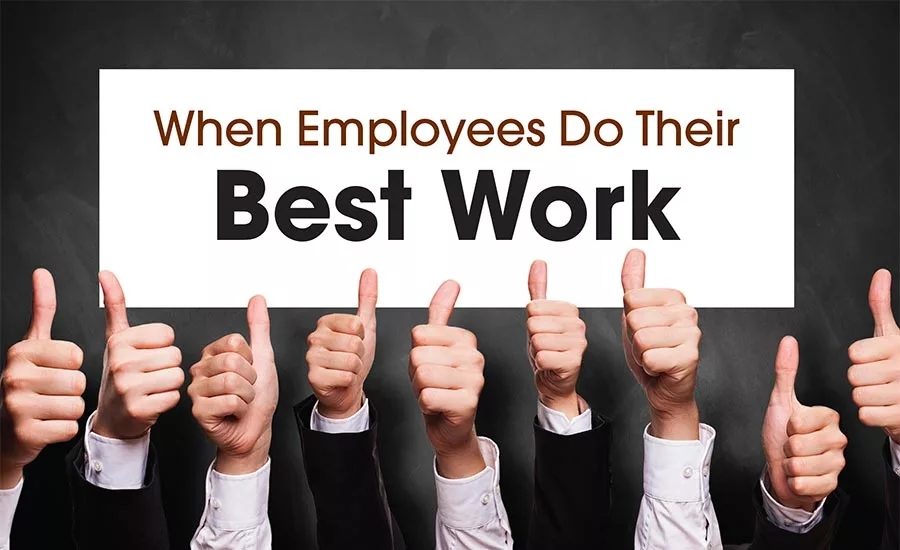When Employees Do Their Best Work

One would normally not think of a tailgate party for an NFL football game as an appropriate venue for providing inspiration for sage business advice. However, when you bring together some pretty intelligent folks, good food, and a few high-octane beverages, you never know where a conversation might go. This is exactly what happened this past fall when I had the privilege of attending such an event with some friends, where theories of employee engagement and productivity started flowing freely.
The good-natured banter surrounding company cultures, bosses, and corporate politics took a sharp turn after our second round of drinks when my fellow members of Steeler Nation began to reminisce about days when they felt they had done their best professional work. Now, we’re not talking about bar stool buddies critiquing last week’s play calling by the offensive coordinator. These guys are accomplished, corporate professionals with MBAs from Carnegie Mellon University’s illustrious Temper School of Business. So, when these guys talk business, it’s usually best to pay attention.
The statement that piqued my interest the most was when one of them proclaimed that he felt as if he did his best work when two conditions existed. The first was when his boss had a direct line to the CEO (healthy working relationship.) And second, when his boss had political capital within the organization that he was willing to spend on his employees to advance the project or business initiative.
On the surface this seemed like a lesson in mastering the art of corporate bureaucracy. However, I was more interested in finding out if these scenarios could be replicated intentionally to maximize workforce productivity. I believe they can and here’s why. Most studies and business writings support a link between employee output and some form of motivation that spurs creativity and innovation. This motivation is generally cultivated on the grounds or environment created by the organization.
The technology sector is a perfect and widely used example of this. The flexible schedules, casual dress codes, plentiful benefits, and lack of stringent corporate policies all represent freedom. This freedom is what allows employees to find their place and become more engaged in their work. The real beauty of this is the intentional nature with which these environments are created. Despite what Hollywood portrayed in the movie The Social Network, the success of tech giants like Facebook was not accidental.
Service sector companies like restoration contractors are no different. While the products and services might differ greatly, the level of employee engagement required to deliver them effectively and profitably are the same. This, coupled with the increasing pressure to produce results with lower operating costs, sets the stage for three fundamental concepts which I believe should be explored to create those two conditions (direct line to the CEO and political capital) mentioned by my friend.

Organizational Design
While the premise of Organizational Design (OD) is rooted largely in the disciplines of human resources, the application is completely operational. This is because OD involves the mechanical arrangement of positions within a company to define hierarchy, teams, reporting structure, lines of communication, and much more. And behind each name and title on the organization chart there is a person with skills, abilities, and relationships.
To achieve the two conditions we are looking for, OD requires careful consideration of the degrees of separation between an employee and the top of the organization chart. The lower the number of degrees of separation, the more direct the line between someone’s boss and the chief. The result is generally an org chart that looks flatter than a traditional pyramid with larger numbers of divisions, work groups, and teams. This provides balance and sets the stage for creating the second condition, political capital.
In context, we can think of political capital as being the amount of credibility and resources a person has stockpiled through relationships, goodwill, and influence in an organization. The key in setting the stage for peak performance with employees is in the boss’s willingness to spend this capital on his employees. A selfless act, albeit, but a necessary one. This makes the personalities behind the names on the org chart even more important.
Strategic Planning Accountability
The link between strategic planning initiatives and accountability should be an obvious one. Stuff needs to get done. People are assigned to get the stuff done and they are given deadlines and the authority to do it. However, we all know it’s not that simple. People get side-tracked and sucked into the whirlwind of daily activities and the time previously allocated for strategic projects and initiatives gets replaced with the more immediate demands of the operation.
The solution to correcting this involves prioritization and congruency with the company’s strategic objectives. This can be done by intentionally creating dependent relationships between projects, activities and tasks, and higher-level objectives in the strategic plan. If we think of this in terms of taking a cross-country road trip with the destination being the objectives, then the projects, activities, and tasks would be the overnight stops along the way. However, those stops should be planned in consideration not just of convenient or interesting locations, but also planned to maximize drive time, fuel stops, traffic conditions, and more. The result is a series of interlinked items that all have a direct impact on the final result.
This prioritization and congruency in the strategic plan, coupled with the OD efforts mentioned earlier, reinforces the importance of direct lines to the chief, because senior management then has the motivation through these dependent relationships to keep the chain of command short and communication efficient. This is traditionally what gives small businesses a distinct advantage over larger organizations when it comes to decision making and implementing strategic initiatives. The whole process is faster and allows businesses to act swiftly on advancing initiatives and capitalize on new opportunities.
This thinking also provides motivation for managers to spend the political capital they have been stockpiling, because they now have a vested interest in the strategic plan initiatives not only up and down the org chart but across it as well. This leads to resource sharing across departments to support the greater good of the company. The ultimate result is collaboration in its finest form through putting the right resources (people) on the projects at the right time.

Performance Reward and Recognition
The final piece to the puzzle in creating the two favorable conditions we are looking for solidifies the motivational side mentioned earlier in the tech sector example. And, we are not talking about participation trophies and employee of the month parking spots. We’re talking about money (compensation and budget), additional resources (more political capital), and opportunity (advancement). All of this aimed at addressing the “what’s in it for me?” question that every employee asks.
Those managers who already have a direct line to the chief understand the value of their position and will go to great lengths to protect it. In most organizations, this means producing results. In order to produce results, managers must have the right people, doing the right things, at the right time. Notice the pattern emerging. In turn, the right people have a strong desire to work for the boss whose team produces results and gains the rewards and recognition referenced earlier. The cycle repeats itself over and over in a way that elevates the organization in a competitive manner, which is healthy because of the congruency and dependency on the strategic plan, leaving little to no room for poor or underperforming individuals.
This concept strongly reinforces the political capital condition on two fronts. The first is with the need for managers to continually spend that capital to accomplish goals and achieve rewards and recognition. The second is with the need to replenish what is being spent for obvious reasons. The more you spend to get stuff done, the more you need to replenish for future initiatives. The real beauty in this concept, however, is in the employees’ desire to work for the boss whose team produces. This creates renewable resources for the managers, teams, departments, and executives alike.
Restorers in today’s market should always be looking for new and innovative ways to engage and motivate employees. Most understand that this now goes well beyond competitive wages and benefits. Today’s workforce wants to be challenged, valued, and part of a winning team. Creating this environment needs to be an active part of the strategic planning process, because employees are going to talk about their company at the next tailgate party. Make sure the topic of conversation is a good one.
Looking for a reprint of this article?
From high-res PDFs to custom plaques, order your copy today!








